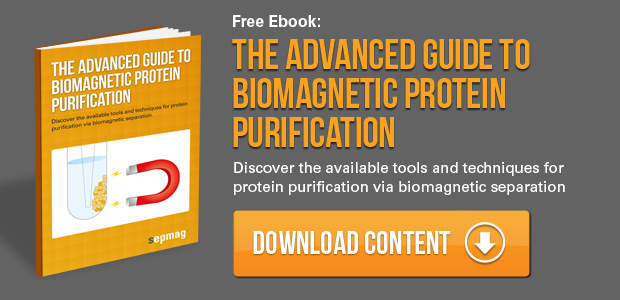As you will find in our protein purification handbook, choosing the right matrix for protein enrichment and purification processes, such as immunoprecipitation or pull-down assays, is an important step in optimizing the efficiency of a protocol. The decision will be based on a number of variables and ultimately depends largely on the nature of the target biomolecule. The goal is to choose a matrix that will not only maximize the final yield, but will also be practical and accessible.
Find more about using biomagnetic separation for protein purification in our Advanced Guide to Biomagnetic Protein Purification:
One well-defined approach is the use of paramagnetic beads. Mag Sepharose beads, for instance, are composed of highly cross-linked agarose particles. These beads contain a surface ligand, which captures the target biomolecule within a sample, either directly or through a bound antibody.
There are several advantages to using Mag Sepharose beads in purification protocols.
- Because Sepharose beads are non-adherent, it is not necessary to add detergents.
- Aggregation problems that might be encountered with other types of beads are not an issue.
- Additionally, the high density and visibility of the beads simplify the collection process, ensuring rapid capture of the bound target protein.
- The beads are collected with a magnetic device rather than centrifugation, which means that the collection time is significantly decreased, taking place in seconds.
- Isolated in this manner, a target protein can be concentrated into volumes from the milliliter down to the microliter scale.
A wide variety of functionalities are available for use, making these types of beads suitable for purifying a range of proteins. Beads can essentially be divided into two categories:
- Pre-activated beads which bind the ligands covalently
- Beads with immobilized ligands which are prepared with ligands.
Pre-activated beads are more flexible with ligand binding occurring at defined sites. N-hydroxysuccinimide (NHS), for example, binds to amino groups in any ligand. Beads containing this surface group are commonly used in pull-down assays. Once an appropriate ligand has been covalently linked to the matrix, the beads can be used to affinity purify the target biomolecules. When the target is eluted, the ligand remains bound to the bead.
Beads with immobilized ligands are more convenient and easy to use. Protein A and Protein G, for example, bind a number of monoclonal and polyclonal antibodies. Each has a distinct affinity profile, but there is some degree of overlap. These types of beads are well-suited for use in immunoprecipitation assays. Antibodies can be cross-linked to the surface ligand so that they remain affixed to the matrix when the target molecule is eluted. Alternatively, the antibody can be eluted along with the target molecule.
The advantage of using Mag Sepharose beads becomes apparent in cases where there the target molecule is present in low relative quantities and where yields are traditionally undetectable by standard methods. Low-abundance molecules such as signaling pathway proteins are usually undetectable via electrophoresis or mass spectrometry (MS) without additional sample preparation. Mag Sepharose beads make it possible to capture such targets from a large starting sample volume, and then subsequently elute it into volumes suitable for SDS-PAGE or MS analysis.
It’s important to bear in mind that each assay is different. Every protocol must be reviewed and modified in order to minimize issues such as non-specific binding before proceeding. Buffers should be optimized in order to maximize binding efficiency and subsequent results. The final parameters of the buffers will depend on the biomolecular composition of the sample. It’s also important to choose the surface group that is best-suited for a particular protocol. Given the availability of a wide range of surface ligands, chances are there will be more than one match for every purification and enrichment assay.
Related articles:
- How to purify recombinant proteins through magnetic particles
- The 3 most important considerations in designing magnetic particles
- Advantages of Magnetic Agarose in Protein Purification
Author: Johan Öhman, Senior Scientist at GE Healthcare, Uppsala, Sweden
 Johan is a chemical engineer with degree from the University of Uppsala in Sweden. He has more than 20 years professional experience focused on protein purification and analysis. His first role was at the bio-pharmaceutical company Kabi Pharmacia working with process development of growth hormones. After this, he worked with high-throughput protein production providing various projects with purified target proteins for structural studies and high-throughput screening of small drug compounds. Johan joined GE Healthcare Life Sciences more than 10 years ago, and he has been working as a Research Engineer/Senior Scientist within the R&D department mainly with protein purification and sample preparation products and applications.
Johan is a chemical engineer with degree from the University of Uppsala in Sweden. He has more than 20 years professional experience focused on protein purification and analysis. His first role was at the bio-pharmaceutical company Kabi Pharmacia working with process development of growth hormones. After this, he worked with high-throughput protein production providing various projects with purified target proteins for structural studies and high-throughput screening of small drug compounds. Johan joined GE Healthcare Life Sciences more than 10 years ago, and he has been working as a Research Engineer/Senior Scientist within the R&D department mainly with protein purification and sample preparation products and applications.





